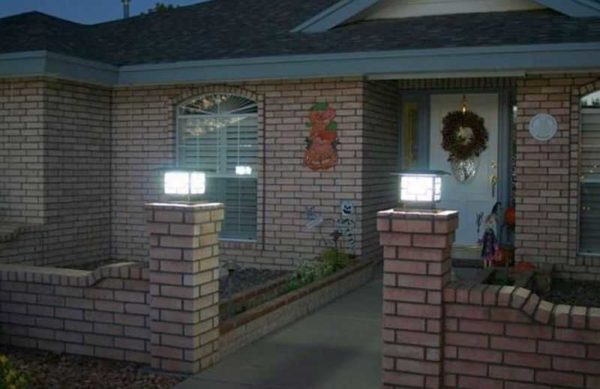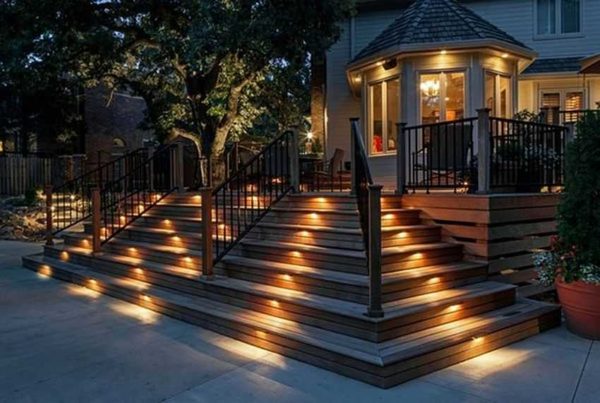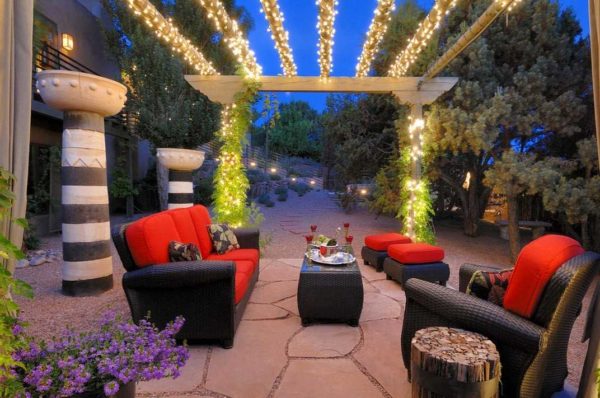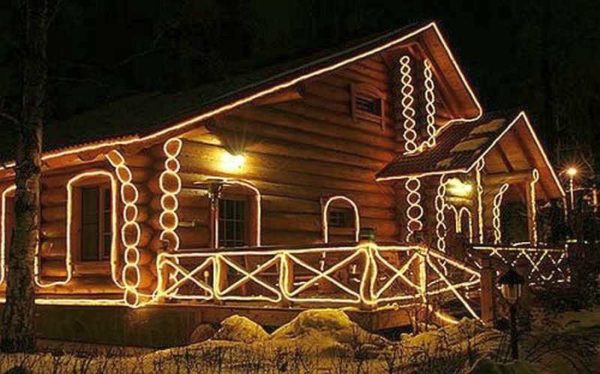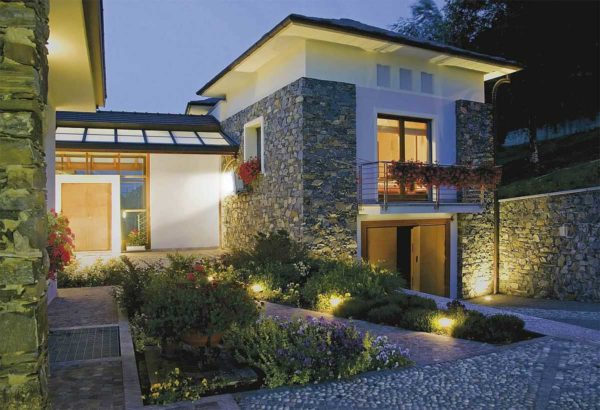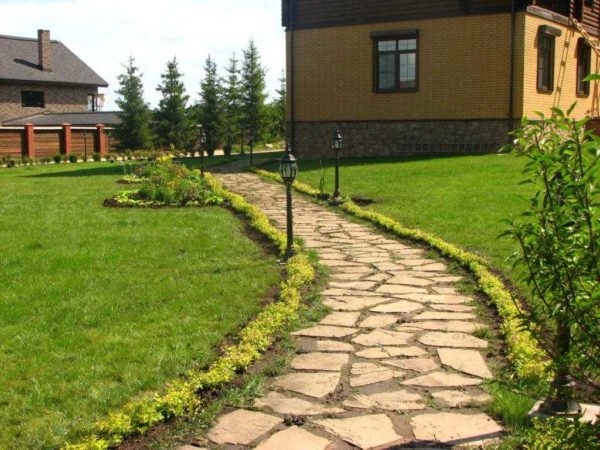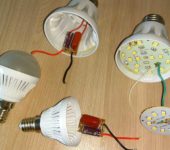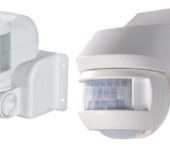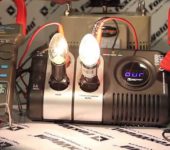Lighting of the site near the house, summer residence
You cannot do without lighting on the site near the house. Even at the dacha, distant lands, at least minimal lighting, but it should be. It's somehow calmer and more comfortable with him. And street lighting of a permanent residence is also a way to decorate the site, give it more individuality in the evening.
The content of the article
Functions and purpose
The lighting of the yard and the local area performs several functions at once:
- Security. In the illuminated area, there is less chance of leaving with impunity, so attackers try to bypass such areas. For protection, they put lamps near the gate, on the porch, near the outbuildings. They are placed at a considerable height to illuminate a larger area. The peculiarity of this type of street lighting is that it burns all the dark hours of the day. There is an option to save money - to put motion sensors. With such a device, the light turns on only when there is at least some movement in the area of the sensor.
- Ensuring the safety of movement. In order not to step on something left on the path in the dark, they are also usually illuminated. Lighting is necessary on stairs, around water bodies. Most often, special street lamps with medium-height legs are used for this. They are installed at some distance from each other on one or both sides of the track. This lighting is turned on until the owners have gone to bed.
- Decorative. To make the yard or garden look no less attractive in the evening than during the day, use decorative lighting. It is usually located on an openveranda, gazebo, near pond or fountain, other decorative elements on the site. With this kind of illumination, wall street lamps, garlands, LED strips, etc. are used. This street lighting at home works only when necessary.
- Festive. To create a festive atmosphere, houses and courtyards are decorated. Festive illumination is optional, but such a pleasant type of lighting.
Typically, the lighting on the site of the house - suburban or suburban - is complex. There is at least a lantern at the doors and gates, a couple of lanterns along the main paths. Spotlights controlled from the house can be installed, illuminating the area if necessary. This is the minimum that provides a normal degree of safety and convenience.
Luminaire selection
It is necessary to install special dust and moisture protected lamps on the street. The degree of protection of the enclosure is indicated by the safety class. It is denoted by the Latin letters IP and two numbers that follow it. The first number reflects the degree of protection against dust, the second - moisture. The lower the number, the lower the protection. For example, IP 44 has a lower protection class than IP 65. The specific meaning of each digit is shown in the photo below.
It is clear that it is better to do street lighting at home with luminaires of IP 68 class, but they are quite expensive, and their range is not so great. But you will not have any problems with their work - neither during rain, nor during a strong wind carrying dust.
What lamps to use
If we talk about lamps for street lighting, it is best to use not incandescent lamps, but LED or economy lamps. The best option is LED. With low power consumption, they shine very brightly.For example, a lamp that consumes 7 watts outputs light as a 50 watt incandescent lamp (or 650 lm). At the same time, they practically do not heat up, so that nearby plastic parts do not overheat. The area of application is somewhat limited by the operating temperature from -20 ° C to + 40 ° C.
If you want to further reduce your street lighting costs, you can install solar-powered luminaires. By the way, these are also light-emitting diode lamps (LED), in the case of which there is a rechargeable battery. During the daytime, the battery accumulates energy, which is then spent on lighting. These luminaires come in a variety of formats - from small ones that stick along the path to solid spotlights that can be used to illuminate roads.
In general, solar-powered street lamps are different in design and installation method. The simplest options - garden ones - can just stick into the ground (in the photo on the left), there are also hanging options that can be hung on trees, a veranda. There are sealed models that can float in water. Launching such a light in a pond is a great solution (second image from the left).
Not so long ago, models appeared that can be built into a walkway or stairs (on the right). They cost quite a lot, but if you consider that the installation costs are minimal (no need to lay a cable), and there are no lighting costs at all, then such an investment is extremely profitable.
Automation on / off
Despite the fact that the presence of sensors requires additional costs and also complicates installation, it is convenient and economical. There are time relays that can turn on and off street lighting at home at a given time. It makes sense to install such systems on security and functional lighting. You can also think about installing a relay for decorative lighting - it's also convenient.
In low-traffic places, where you need to turn on the light only when you are there, you can put motion sensors. They can also be part of security lighting - if there is movement, searchlights that have not worked before will turn on. The surprise will not be pleasant. Another thing is that the sensor can work on a dog or other animal that comes into its field of vision. But security functions will still be more effective.
Another possibility to automate the street lighting of a private house is to install a photo relay. It reacts to a decrease in the amount of light by turning on the lamp supply circuit. Also, in automatic mode, the power is turned off - when the sun begins to rise.
Another video on the topic
Posting and order of work
First of all, it is necessary to draw up a detailed plan of the illuminated area, which indicates the location of all lamps. Next, it is necessary to develop a route that will connect those light sources that need power (except for those that are solar-powered). IN house dashboard a separate machine must be installed on street lighting. In some cases, it may require several separate power lines (for example, one for lighting the fence and the area in front of the house, for the backyard - the second).
Choosing a cable
It is advisable to lay the power cable for the luminaires underground. The minimum laying depth is 80 cm; it is desirable to use armored cable types. Laying is allowed cable VVG, but in a protective sheath (special corrugated sleeve or asbestos-cement pipes). Read more about underground cable laying here.
Air laying of the cable for lamps is also allowed, but, firstly, it spoils the overall impression, and secondly, it is necessary to find a cable whose sheath is not afraid of ultraviolet radiation.These are certain types of polyethylene, the sheaths of which significantly increase the cost of cable products. Most often, a VVG cable is used here, but it requires protection from ultraviolet radiation. It must be laid in cable channels (if they lead along the walls of buildings) or corrugated hoses. Without such protection, after a few years (3-4 years depending on the region), the shell will crack, which can lead to the failure of the entire system.
The choice of cable section is described here, read about how to connect wires here.
Where to put the switches
A few words about choosing a place for installing switches for street lighting at home. The system can be quite complex - they separately pull power to the lights on the fence, separately - for lighting along the paths, another branch - for decorative lighting. But it is desirable to concentrate all switches inside the house, and most conveniently - near the front door.
The disadvantage of this scheme is that it is necessary to turn off and on the lighting from home. You can make such a scheme more convenient using a remote control system. But this is expensive equipment. Cheaper installation pass-through switches... They make it possible to turn on / off the light from two / three points. You can put one inside the house, the other on the fence, near the garage, etc.

